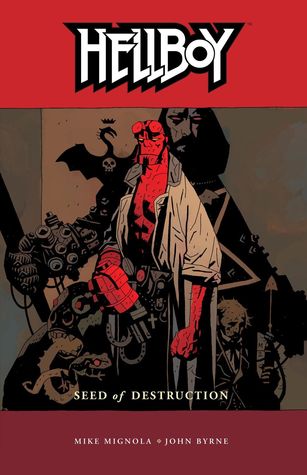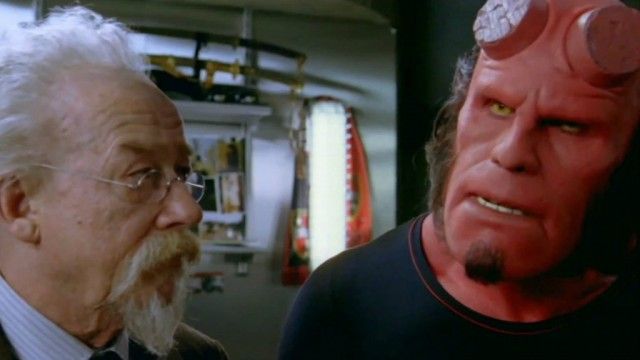 I saw the Hellboy movie years ago and loved it. Rasputin and the Nazis, Lovecraftian monsters, Gothic ruins, arcane machines, and a wise-cracking, cigar chomping, good demon who kicks ass. I didn't know anything about how Hellboy was supposed to be, but I thought Perlman knocked it out of the park.
I saw the Hellboy movie years ago and loved it. Rasputin and the Nazis, Lovecraftian monsters, Gothic ruins, arcane machines, and a wise-cracking, cigar chomping, good demon who kicks ass. I didn't know anything about how Hellboy was supposed to be, but I thought Perlman knocked it out of the park.
I always meant to get around to reading the comic, but I didn't get a chance until now. Starting at the beginning, I see that the movie and the book start off on the same page, but then wildly veer off in different directions with only loose connections as the stories unfold. This is going to be blasphemous of me to say, but I liked the movie more.
In the movie, more time was spent developing the characters and the backstory. In the comic, Hellboy and the reader are subjected to a bad case of monologuing (I've had characters do it, too. It happens to writers all the time.) by Rasputin. As the comic is told almost exclusively from Hellboy's POV—after his origin sequence—there's no other place to put it. Perhaps if this opening story had been told over eight issues instead of four, there might have been a better way to develop it organically.
 Hellboy's relationships with other characters is largely undeveloped in this issue of the comic. Other than a little background on Abe and Liz, we really don't get any reason why Hellboy cares about them. And Professor Bruttenholm? Forget it. In the movie, Perlman and Hurt really develop the relationship. Here, it's over before it starts with nary a thought or feeling. I have to imagine that these relationships and characters were expounded upon in subsequent issues.
Hellboy's relationships with other characters is largely undeveloped in this issue of the comic. Other than a little background on Abe and Liz, we really don't get any reason why Hellboy cares about them. And Professor Bruttenholm? Forget it. In the movie, Perlman and Hurt really develop the relationship. Here, it's over before it starts with nary a thought or feeling. I have to imagine that these relationships and characters were expounded upon in subsequent issues.
But despite these shortcomings, I liked the story. The Lovecraftian vibe, Rasputin, and occult-Nazis are there with their arcane machines. The Hellboy that Perlman brought to life is a bit more subdued though. The raw power is there, but still in a more embryonic state. There's clearly more to come.
Mignola's art really captures the brooding darkness. Even bright yellow energetic struggles to keep it at bay and won't last long against the suffocating gloom. Sepia tones lend age and authenticity to portraits on a wall. Hellboy pops off the page with his signature fire engine red, particularly when contrasted against the moodier background hues of blue, purple, and gray or contrasting with green-colored foes. And black. Always black.
At the end of this volume, there were a couple notes from Mignola about the origin of Hellboy's appearance, two short four-page comics, and a gallery of Hellboy portraits as interpreted by other artists. It was a nice addition.
3.5 stars.
\_/
DED
No comments:
Post a Comment